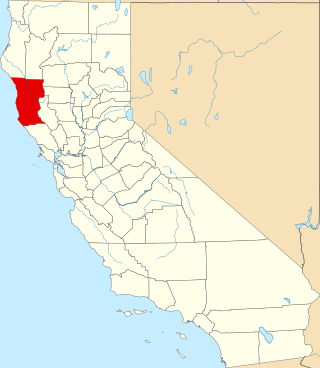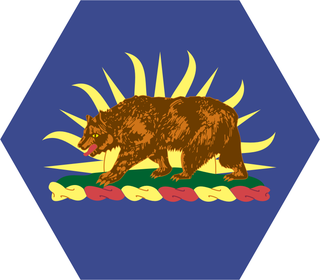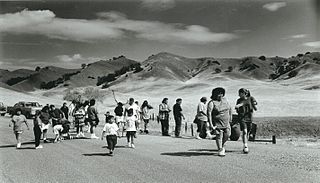
George R. Crook was a career United States Army officer who served in the American Civil War and the Indian Wars. He is best known for commanding U.S. forces in the 1886 campaign that led to the defeat of the Apache leader Geronimo. As a result, the Apache nicknamed Crook Nantan Lupan, which means "Grey Wolf."

The Pit River is a major river draining from northeastern California into the state's Central Valley. The Pit, the Klamath and the Columbia are the only three rivers in the U.S. that cross the Cascade Range.

The Sioux Wars were a series of conflicts between the United States and various subgroups of the Sioux people which occurred in the later half of the 19th century. The earliest conflict came in 1854 when a fight broke out at Fort Laramie in Wyoming, when Sioux warriors killed 31 American soldiers in the Grattan Massacre, and the final came in 1890 during the Ghost Dance War.

The Mariposa War, also known as the Yosemite Indian War, was a conflict between the United States and the indigenous people of California's Sierra Nevada in the 1850s. The war was fought primarily in Mariposa County and surrounding areas, and was sparked by the discovery of gold in the region. As a result of the military expedition, the Mariposa Battalion became the first non-indigenous group to enter Yosemite Valley and the Nelder Grove.

The Mendocino War was a conflict between the Yuki and white settlers in Mendocino County, California between July 1859 and January 18, 1860. It was caused by settler intrusion and slave raids on native lands and subsequent native retaliation, resulting in the deaths of hundreds of Yuki.

California's involvement in the American Civil War included sending gold east to support the war effort, recruiting volunteer combat units to replace regular U.S. Army units sent east, in the area west of the Rocky Mountains, maintaining and building numerous camps and fortifications, suppressing secessionist activity and securing the New Mexico Territory against the Confederacy. The State of California did not send its units east, but many citizens traveled east and joined the Union Army there, some of whom became famous.

The Round Valley Indian Reservation is a federally recognized Indian reservation lying primarily in northern Mendocino County, California, United States. A small part of it extends northward into southern Trinity County. The total land area, including off-reservation trust land, is 93.939 km2. More than two-thirds of this area is off-reservation trust land, including about 405 acres (1.64 km2) in the community of Covelo. The total resident population as of the 2000 census was 300 persons, of whom 99 lived in Covelo.

The Battle of Powder River, also known as the Reynolds Battle, occurred on March 17, 1876, in Montana Territory, United States, as part of the Big Horn Expedition. The attack on a Northern Cheyenne and Oglala Lakota Indian encampment by Colonel Joseph J. Reynolds initiated the Great Sioux War of 1876. Although destroying a large amount of Indian property, the attack was poorly carried out and solidified Northern Cheyenne and Lakota Sioux resistance to the U.S. attempt to force them to sell the Black Hills and live on a reservation.

The California Army National Guard is one of three components of the California National Guard, a reserve of the United States Army, and part of the National Guard of the United States. The California Army National Guard is composed of 18,450 soldiers. Nationwide, the Army National Guard comprises approximately one half of the US Army's available combat forces and approximately one third of its support organization. National coordination of various state National Guard units are maintained through the National Guard Bureau.

The Nome Cult Trail also known as the Concow Trail of Tears refers to the state-sanctioned forced removal of the Northern Californian Concow Maidu people during the 1860s to Round Valley Reservation. This historic trail is located in present-day Mendocino National Forest which follows Round Valley Road, through Rocky Ridge and the Sacramento Valley. On August 28, 1863, the Konkow Maidu were ordered by the California state militia to report to the Bidwell Ranch in Chico to be removed to the Round Valley Reservation at Covelo in Mendocino County. Any Native Americans remaining in the area were to be shot. 461 Concow Maidu were forced to march under guard west out of the Sacramento Valley and through to the Coastal Range. Only 277 reached Round Valley reservation on September 18, 1862 as 150 were too ill and malnourished to finish the march, 32 died en route, and 2 escaped.

The Great Sioux War of 1876, also known as the Black Hills War, was a series of battles and negotiations that occurred in 1876 and 1877 in an alliance of Lakota Sioux and Northern Cheyenne against the United States. The cause of the war was the desire of the US government to obtain ownership of the Black Hills. Gold had been discovered in the Black Hills, settlers began to encroach onto Native American lands, and the Sioux and the Cheyenne refused to cede ownership. Traditionally, American military and historians place the Lakota at the center of the story, especially because of their numbers, but some Native Americans believe the Cheyenne were the primary target of the American campaign.

The Pit River Tribe is a federally recognized tribe of eleven bands of indigenous peoples of California. They primarily live along the Pit River in the northeast corner of California. Their name also is spelled as "Pitt River" in some historical records.
The District of California was a Union Army command department formed during the American Civil War. The district was part of the Department of the Pacific, the commander of the department also being District commander. The district was created as a separate command on July 1, 1864, after Irvin McDowell took command of the Department of the Pacific, relieving General Wright, who then remained as District of California commander. The District comprised the state of California and the areas of the Rogue River and Umpqua River in Southern Oregon. Its headquarters were in San Francisco, co-located with those of the Department of the Pacific. On March 14, 1865, the District of Oregon was extended to include the entire state of Oregon, removing the Rogue River and Umpqua River areas from the District.

The Bald Hills War (1858–1864) was a war fought by the forces of the California Militia, California Volunteers and soldiers of the U.S. Army against the Chilula, Lassik, Hupa, Mattole, Nongatl, Sinkyone, Tsnungwe, Wailaki, Whilkut and Wiyot Native American peoples.
Isaac Green Messec, sometimes Messic or Messick (1823–1901) was a Texas Ranger, 49er, miner, businessman, California State Militia Captain, county sheriff, sergeant-at-arms of the California State Senate and rancher, a well-known figure in political and mining circles early in the history of the State of California.
William Chauncey Kibbe was a California pioneer and the third Adjutant General of California. He oversaw the California Militia from its beginnings through most of the American Civil War.

Mendocino Indian Reservation, a former Indian reservation in Mendocino County, one of the early Indian reservations to be established in California by the federal government for the resettlement of California Indians. It was established in the spring of 1856, in the vicinity of modern Noyo. Its area was 25,000 acres and its boundary extended north from what is now Simpson Lane at 39°24′43″N123°48′30″W to Abalobadiah Creek and east from the Pacific Ocean to a north–south line passing through the summit of Bald Hill.
The California Indian Wars were a series of wars, battles, and massacres between the United States Army, and the Indigenous peoples of California. The wars lasted from 1850, immediately after Alta California, acquired during the Mexican–American War, became the state of California, to 1880 when the last minor military operation on the Colorado River ended the Calloway Affair of 1880.
The Round Valley Settler Massacres of 1856–1859 were a series of massacres committed by early White settlers of California with cooperation and funding from the government of California and the support of prominent Californians against the Yuki people of Round Valley, Mendocino County, California. More than 1,000 Yuki are estimated to have been killed; many others were enslaved and only 300 survived. The intent of the massacres was to exterminate the Yuki and gain control of the land they inhabited. U.S. Army soldiers deployed to the valley stopped further killings. In 1862, the California legislature revoked a law which permitted the kidnapping and enslavement of Native Americans in the state.













